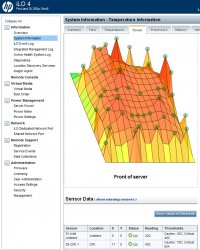For the "quiet workstation" space, some the real quietness comes from having individually controlled fans for each heat region. The case fan spins slowly (and quietly assuming that a large diameter slow RPM fan is part of the design) until the ambient temperature in the case rises, then the case fan (only) spins up a bit. The power supply fan similarly speeds and slows according to the temperature of the PS. The CPU fan (usually a 4 wire PWM fan that can slow to barely moving) takes care of the CPU. The GPU(s) fan(s) are controlled by the GPU card.
Assuming a traditional workstation design, this is quite true.
Problematically, this "truth" is also based on the main limitation of the traditional ATX box design - the fact, that the box contains too much air, and that this air can not be transferred effectively - there are always pockets of air, which are not moved, etc. A fan is, by necessity, circular, whereas computer housing designs have (traditionally) been cubic - creating big problems. In short - you only have to look at the shape of a golfball to understand that aerodynamics is a complex interaction.
I once saw a video on Youtube (but could not find it), which used "colored air" to visualize the airflow of a tower desktop, and it looked quite bad. The narrator of the Video made the point of noting, that the amount of dust gathered within desktop boxes (even on non-static surfaces) is testament to the relatively shabby airflow within the box.
To make another note:AidenShaw uses the example of the GPU controlling the GPU fan, and admittedly - on the face of it - the argument makes sense. What in fact does not make sense is that the GPU has no control of it's ambient temperature and the (standard-based) limitations placed on GPU cards form factors make the optimality of GPU-controlled GPU cooling a sad joke.
It is true, that one central cooling element (i.e. thermal core) and one fan (to rule them all) may produce problems as the cooling needs of different components vary, especially at different load profiles. Then again, most laptop users have had to contend with the setup for years, and by and large: it works.
Thus far, we've only seen tidbits of the nMP (and I'm definitely waiting for a teardown and Anand's inquisitive eye), but for the nMP to fulfill its potential:
- the effectiveness of thermal transfer in the thermal core (both from the contact surface to the airflow-heatsink-interface and from different parts of the thermal core) is crucial. This is largely defined by the thermal conductivity of the heatsink material and the physical form of the heatsink. I have no hard data on the material used in the heatsink, but the surprisingly low number of dissipator blades in the heatsink makes me wonder...
- the thermal compound needs to be stellar - a topic where Apple traditionally has not been strong
- The airflow needs to be really good, not only quantitatively but "qualitatively" as well. The ability of a heatsink to shed heat is defined as much by the temperature gradient as by the airflow profile. Traditional fans have always suffered due to the fan-engine being in the middle and thus creating an erratic airflow profile (basically creating a flow vortex "behind" the fan motor). This has always been a problem with component fans, which need to fit within a box (such as 80x80x25 mm), because simply adding a cone on top of the fan motor would significantly improve the profile of the airflow. I have yet to see anything but promo pictures, but in designing a special fan, Apple has at least had the potential to address some of the typical problems.
We've heard PR-statements on the noise-level of the nMP, and even though the we'd take that data with a sack of salt, the promises are ... promising. Whether the results are reached through a thermal innovation or CPU/GPU throttling remains to be seen, as well as whether we'll have problems with overheating electrolytic condensers is a question for the future...
RGDS,




